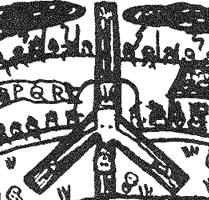 Having grown up in the 'hippie era', a Peace sign seemed like a good choice for a pendant to hang from the personal prayer bead set I'm creating for myself. Being an inquisitive person, I decided to look up a bit about the history of the symbol. What I found out surprised and shocked me! Being curious, it seems, is not always a good thing.
Having grown up in the 'hippie era', a Peace sign seemed like a good choice for a pendant to hang from the personal prayer bead set I'm creating for myself. Being an inquisitive person, I decided to look up a bit about the history of the symbol. What I found out surprised and shocked me! Being curious, it seems, is not always a good thing. The internationally recognized symbol for peace was created for the nuclear disarmament movement by Gerald Holtom, a British artist & designer, in 1958. It is meant to be a representation from the naval code of semaphore for the letters N & D, superimposed on top of each other. The outer circle represents the concept of 'total' or 'complete' and surrounds the N & D to signify 'Total or Complete Nuclear Disarmanent'.
The internationally recognized symbol for peace was created for the nuclear disarmament movement by Gerald Holtom, a British artist & designer, in 1958. It is meant to be a representation from the naval code of semaphore for the letters N & D, superimposed on top of each other. The outer circle represents the concept of 'total' or 'complete' and surrounds the N & D to signify 'Total or Complete Nuclear Disarmanent'. However, to my chagrin, I found that this same symbol has a very dark past, much older than that. It was used by Hitler's 3rd Panzer Division from 1941 - 1945 on their regimental badge, seen to the left. Many Soviet, Polish & Hungarian people, having suffered atrocities under the Nazis, must certainly have struggled with it's use as a way to communicate peace. The symbol can be found on the tombstones of many of Hitler's SS troops also.
However, to my chagrin, I found that this same symbol has a very dark past, much older than that. It was used by Hitler's 3rd Panzer Division from 1941 - 1945 on their regimental badge, seen to the left. Many Soviet, Polish & Hungarian people, having suffered atrocities under the Nazis, must certainly have struggled with it's use as a way to communicate peace. The symbol can be found on the tombstones of many of Hitler's SS troops also. There are numerous associations with Satanism & as a symbol of a 'broken Jew' or 'broken cross' from as early as the first century A.D. The Emperor Nero, who despised Christians, crucified the Apostle Peter on a cross head downward. Today, heavy metal lyrics & imagery use it to communicate anti-Christian sentiments. It has been used to support communism & the 'anti-God' movement for many years. The founder of the Church of Satan depicted it on the backdrop for his altar.
There are numerous associations with Satanism & as a symbol of a 'broken Jew' or 'broken cross' from as early as the first century A.D. The Emperor Nero, who despised Christians, crucified the Apostle Peter on a cross head downward. Today, heavy metal lyrics & imagery use it to communicate anti-Christian sentiments. It has been used to support communism & the 'anti-God' movement for many years. The founder of the Church of Satan depicted it on the backdrop for his altar. Holtom was horrified when he discovered that the peace symbol had such a long history of hatred & despair. He tried to encourage it to be turned upside down, as illustrated by the picture on the left. When the peace symbol is inverted the letter "N" becomes the semaphore code for "U" which could mean 'universal' disarmament or 'unilateral' disarmament.
Holtom was horrified when he discovered that the peace symbol had such a long history of hatred & despair. He tried to encourage it to be turned upside down, as illustrated by the picture on the left. When the peace symbol is inverted the letter "N" becomes the semaphore code for "U" which could mean 'universal' disarmament or 'unilateral' disarmament.With this unsavoury past, can I still use the 'peace sign' as a symbol of peace & love on my prayer beads? What's more significant, the history of it or my personal, long standing perception of its meaning? A perception that has now been tainted.










